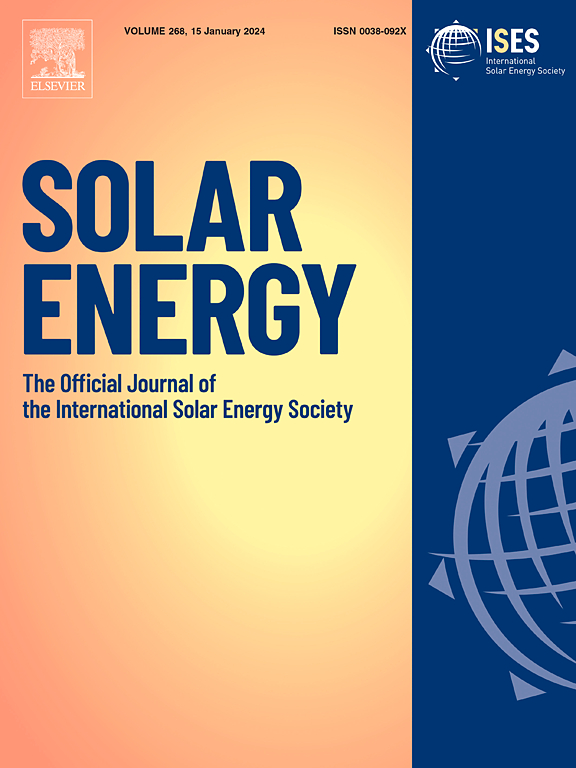对 SrMnO3 立方包晶进行光电评估,以展望可见光太阳能光伏应用前景
IF 6
2区 工程技术
Q2 ENERGY & FUELS
引用次数: 0
摘要
下一代太阳能电池材料具有优异的光电和光伏性能,必须避免卤化铅钙钛矿的毒性和降解问题。在这方面,具有良好光电性能的过渡金属氧化物钙钛矿具有重要意义。在这项工作中,我们报告了对三立方钙钛矿SrMnO3 (SMO)光电特性的理论和实验相结合的研究,SMO有望用于可见光光伏应用。利用第一原理密度功能理论计算,我们发现具有立方对称性的SMO具有直接的带隙特性(~ 0.62 eV),特殊的吸收行为(在可见光范围内~ 105 cm−1),可观的介电常数(~ 11)和相当小的激子结合能(~ 44 meV),从而保证了相当大的光伏响应(PCESLME ~ 16%)。采用脉冲激光沉积(PLD)技术在掺氟氧化锡(FTO)镀膜玻璃基板上生长SMO薄膜。结构表征表明相纯SMO具有立方对称。室温霍尔测量可以确定大多数载流子的性质(p型)和浓度(1.37 × 1012 cm−3),电导率(5.56 × 10−26 S/cm)和载流子迁移率(24.5 cm2/V·S),与原型卤化物钙钛矿CH3NH3PbI3 (MAPbI3)相当。紫外光电子能谱进一步测定了价带和导带边缘对应的能量,这对器件制造至关重要。器件的初始表征显示出微小而有限的光伏响应,这表明需要彻底优化器件的制造参数和开发合适的空穴传输层。本文章由计算机程序翻译,如有差异,请以英文原文为准。
Optoelectronic evaluation of SrMnO3 cubic perovskite for prospective visible light solar photovoltaic application
Next-generation solar cell materials with superior optoelectronic and photovoltaic properties must circumvent the toxicity and degradation issues of hybrid lead halide perovskites. In this regard, transition metal oxide perovskites with favourable optoelectronic properties are of significant relevance. In this work, we report a combined theoretical–experimental investigation into the optoelectronic properties of cubic-perovskite, SrMnO3 (SMO) for prospective visible-light photovoltaic application. Using first-principles density functional theory calculations, we show that SMO with cubic symmetry demonstrates a direct bandgap character (∼0.62 eV), exceptional absorption behaviour (∼105 cm−1 in the visible range), substantial dielectric constant (∼11) and a reasonably small exciton binding energy (∼44 meV) promising a sizeable photovoltaic response (PCESLME ∼ 16 %). Accordingly, thin films of SMO were grown on fluorine-doped tin oxide (FTO) coated glass substrate using pulsed laser deposition (PLD) technique. Structural characterization demonstrated phase pure SMO with cubic symmetry. Room-temperature Hall measurement allowed the determination of the nature (p-type) and concentration (1.37 × 1012 cm−3) of majority charge carriers, conductivity (5.56 × 10−⁶ S/cm), and carrier mobility (24.5 cm2/V·s) which are reasonably comparable to those of archetypal halide perovskite, CH3NH3PbI3 (MAPbI3). Ultraviolet photoelectron spectroscopy further allowed the determination of energies corresponding to valence and conduction band edges, crucial for device fabrication. Initial device characterization demonstrates small yet finite photovoltaic response, suggesting the requirement of thorough optimization of the device fabrication parameters and development of a suitable hole transport layer.
求助全文
通过发布文献求助,成功后即可免费获取论文全文。
去求助
来源期刊

Solar Energy
工程技术-能源与燃料
CiteScore
13.90
自引率
9.00%
发文量
0
审稿时长
47 days
期刊介绍:
Solar Energy welcomes manuscripts presenting information not previously published in journals on any aspect of solar energy research, development, application, measurement or policy. The term "solar energy" in this context includes the indirect uses such as wind energy and biomass
 求助内容:
求助内容: 应助结果提醒方式:
应助结果提醒方式:


